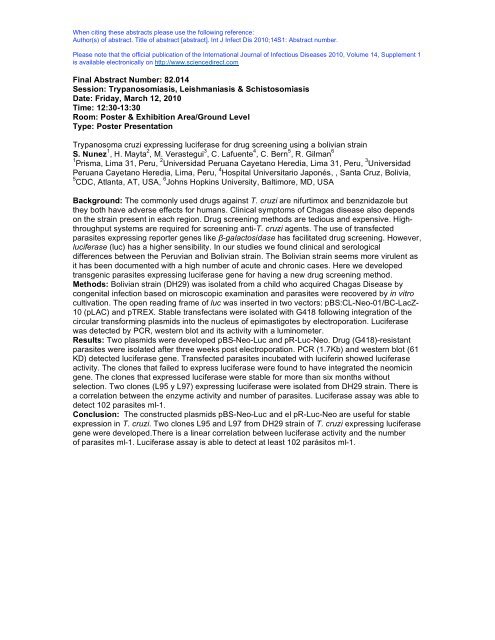14th ICID - Poster Abstracts - International Society for Infectious ...
14th ICID - Poster Abstracts - International Society for Infectious ...
14th ICID - Poster Abstracts - International Society for Infectious ...
Create successful ePaper yourself
Turn your PDF publications into a flip-book with our unique Google optimized e-Paper software.
When citing these abstracts please use the following reference:<br />
Author(s) of abstract. Title of abstract [abstract]. Int J Infect Dis 2010;14S1: Abstract number.<br />
Please note that the official publication of the <strong>International</strong> Journal of <strong>Infectious</strong> Diseases 2010, Volume 14, Supplement 1<br />
is available electronically on http://www.sciencedirect.com<br />
Final Abstract Number: 82.014<br />
Session: Trypanosomiasis, Leishmaniasis & Schistosomiasis<br />
Date: Friday, March 12, 2010<br />
Time: 12:30-13:30<br />
Room: <strong>Poster</strong> & Exhibition Area/Ground Level<br />
Type: <strong>Poster</strong> Presentation<br />
Trypanosoma cruzi expressing luciferase <strong>for</strong> drug screening using a bolivian strain<br />
S. Nunez 1 , H. Mayta 2 , M. Verastegui 3 , C. Lafuente 4 , C. Bern 5 , R. Gilman 6<br />
1 Prisma, Lima 31, Peru, 2 Universidad Peruana Cayetano Heredia, Lima 31, Peru, 3 Universidad<br />
Peruana Cayetano Heredia, Lima, Peru, 4 Hospital Universitario Japonés, , Santa Cruz, Bolivia,<br />
5 CDC, Atlanta, AT, USA, 6 Johns Hopkins University, Baltimore, MD, USA<br />
Background: The commonly used drugs against T. cruzi are nifurtimox and benznidazole but<br />
they both have adverse effects <strong>for</strong> humans. Clinical symptoms of Chagas disease also depends<br />
on the strain present in each region. Drug screening methods are tedious and expensive. Highthroughput<br />
systems are required <strong>for</strong> screening anti-T. cruzi agents. The use of transfected<br />
parasites expressing reporter genes like -galactosidase has facilitated drug screening. However,<br />
luciferase (luc) has a higher sensibility. In our studies we found clinical and serological<br />
differences between the Peruvian and Bolivian strain. The Bolivian strain seems more virulent as<br />
it has been documented with a high number of acute and chronic cases. Here we developed<br />
transgenic parasites expressing luciferase gene <strong>for</strong> having a new drug screening method.<br />
Methods: Bolivian strain (DH29) was isolated from a child who acquired Chagas Disease by<br />
congenital infection based on microscopic examination and parasites were recovered by in vitro<br />
cultivation. The open reading frame of luc was inserted in two vectors: pBS:CL-Neo-01/BC-LacZ-<br />
10 (pLAC) and pTREX. Stable transfectans were isolated with G418 following integration of the<br />
circular trans<strong>for</strong>ming plasmids into the nucleus of epimastigotes by electroporation. Luciferase<br />
was detected by PCR, western blot and its activity with a luminometer.<br />
Results: Two plasmids were developed pBS-Neo-Luc and pR-Luc-Neo. Drug (G418)-resistant<br />
parasites were isolated after three weeks post electroporation. PCR (1.7Kb) and western blot (61<br />
KD) detected luciferase gene. Transfected parasites incubated with luciferin showed luciferase<br />
activity. The clones that failed to express luciferase were found to have integrated the neomicin<br />
gene. The clones that expressed luciferase were stable <strong>for</strong> more than six months without<br />
selection. Two clones (L95 y L97) expressing luciferase were isolated from DH29 strain. There is<br />
a correlation between the enzyme activity and number of parasites. Luciferase assay was able to<br />
detect 102 parasites ml-1.<br />
Conclusion: The constructed plasmids pBS-Neo-Luc and el pR-Luc-Neo are useful <strong>for</strong> stable<br />
expression in T. cruzi. Two clones L95 and L97 from DH29 strain of T. cruzi expressing luciferase<br />
gene were developed.There is a linear correlation between luciferase activity and the number<br />
of parasites ml-1. Luciferase assay is able to detect at least 102 parásitos ml-1.
















